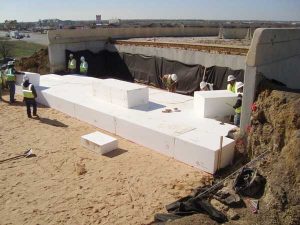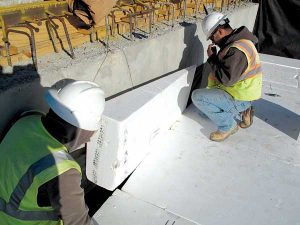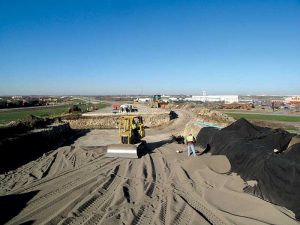A Texas Roadway Rehabilitation Explores Alternative Embankment Fills and Exposes a Little More Than Expected
Large-scale construction requires making many decisions far in advance of the on-site construction work. Engineers and architects guide clients through a myriad of decisions while creating the drawings and specifications during the design phase of the project. Ultimately, successful projects are about making good decisions before moving the first shovel of dirt and then putting detailed plans and drawings into the hands of skilled people to do the work.
The U.S. 67 bridge over SH 174 outside of Cleburne, TX, needed rehabilitation which was delegated to Ed Bell Construction, as they were working on an adjacent section of highway. The bridge header was settling because deteriorating embankments at either end were causing the pavement to bunch up where the road connects to the bridge. TxDOT had already attempted to rehabilitate the embankments using traditional soil stabilization methods, but moisture issues and settlement continued. As the previous traditional repairs did not stabilize the embankment, a side-by-side comparison was requested of two different fill materials, a lightweight aggregate and a Geofoam.”

Lightweight, yet incredibly strong, the geofoam blocks are moved into position by laborers while engineers assure the stack configuration is built as specified.
The first task on the contract was to rehabilitate the actual bridge over SH 174, which was being diminished by failing embankments. Once the bridge was sound, the embankments were excavated in sections roughly 6 feet deep and 120 feet long, giving builders a fresh, wide trench on either side of the bridge to fill with the alternative fill materials. After each trench was filled, it was to be paved over with the new road, reconnecting both sides to the rehabilitated bridge. Working with two different structural fills, Ed Bell Construction’s assignment on the embankments was to plan and complete the work on each side of the bridge. They would also install electronic pressure monitors beneath each of the restructured embankments so any future settlement could be monitored independently. The project had the potential for a great learning experience and a chance to rethink common construction processes for soil embankments.
TxDOT indicated they wanted to compare a kiln-processed lightweight clay aggregate and solid, lightweight Geofoam blocks as alternative fills. On the surface, the contractor’s early expectation was that the aggregate materials would behave similarly to soil. However, regarding the geofoam block side, there were concerns.
The lightweight aggregate is supplied from a single manufacturer in North Texas and did not offer many choices. The Geofoam required additional research before the product could be selected. Two different Geofoam suppliers were engaged to provide background on, and competitively secure, the materials. The product ultimately selected was Foam-Control® EPS 22 Geofoam from ACH Foam Technologies, which offers a compressive strength of 7.3 psi at 1% deformation. Geofoam blocks manufactured at a higher density can withstand up to 18.6 psi. ACH Foam Technologies produces Geofoam in several different densities ranging from EPS 12 with a compressive resistance of 2.2 psi to EPS 46 at 18.6 psi at 1% deformation.

ACH Foam Technologies works with engineers and builders to establish precisely-defined purchase orders that can be delivered to job sites in sequences that facilitate accurate and efficient placement of every piece.
Furthermore, through a collaboration preconstruction process, blocks can be manufactured to size and delivered in a just-in-time delivery sequence to minimize the need for on-site material storage. Shop drawings of the block configuration pattern were produced to validate the structural soundness of the embankment. To facilitate construction, blocks were numbered and delivered in sequence to ensure easy, precise placement according to the plan.
With traffic diverted, the bridge remediated, and the trenches dug, all that was left to do was build the embankments and document the work. Both trenches were lined with a filter fabric before the new fill materials went in. On the lightweight aggregate side, a truck simply backed up to the hole and dumped in the material, which the contractor compared to kitty litter in texture. The aggregate was graded flat and covered with more fabric, performing largely the same way soil would under the grader.
On the Geofoam side, first a sand leveling course was put down to produce a flat surface. The Geofoam blocks were laid in by hand with no specialized equipment or skilled labor involved. Two men easily moved blocks as large as 8 by 4 feet, weighing less than 100 pounds. The majority of the blocks required no modification, but workers were able to quickly customize blocks to fill in around the superstructure using a hand-held hotwire cutter. With the Geofoam stacked and wrapped in fabric just like the aggregate side, there were two ready-to-pave embankments made from very different materials. Special sensors had been placed beneath both types of fill to allow TxDOT to closely monitor each material’s settlement post construction.

Despite textural similarities between soil and the kiln-processed lightweight clay aggregate, builders found the kitty-litter like material to be less solid than expected when paving the road, increasing the time required to deliver a smooth surface.
The next step was to lay the road down. The road plan called for a crushed limestone base subgrade, covered with a hot asphalt mix and topped with 10-inch concrete paving. An initial concern that the Geofoam side would be soft under the equipment was quickly allayed, as the Geofoam provided a solid surface as the base was pushed out with a dozer. On the aggregate side, the fill was softer under the equipment and took longer to surface. The contractor decided to use a lightweight truss screed bridge paver on the aggregate side rather than a traditional concrete paver to put in the final topping, to avoid damaging the embankments with heavy construction equipment,
More than five years since the original embankments were built, data suggests both alternative fills have performed adequately. On the lightweight aggregate side, the fill settled slightly more than was initially expected but was still within TxDOT’s acceptable tolerances. On the Geofoam side, there was a quick initial settlement and then no further movement at all, performing better than expected. The department has been satisfied with the work and the lack of return maintenance since the rehabilitation was completed in 2012.▪
Tom Huempfner is Vice President of Sales and Marketing at ACH Foam Technologies. He has authored many educational seminars and articles for publication, and has conducted numerous educational seminars on molded polystyrene all over the U.S. (tomhuempfner@achfoam.com)
